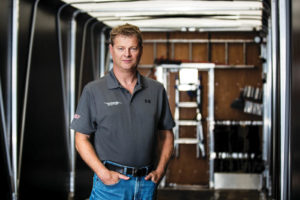 “As a company, we believe in the Japanese principle of Kaizen, which is the philosophy of continuous improvement,” says Lloyd Verduyn, president and owner of Verduyn Tarps, based in Hamilton, Ontario, Canada. “For us, that extends beyond processes and personal efficiency to our products as well. We’re never finished making our tarp systems better. That commitment to continuous improvement has made Verduyn Tarps a forerunner in tarping system technologies.”
“As a company, we believe in the Japanese principle of Kaizen, which is the philosophy of continuous improvement,” says Lloyd Verduyn, president and owner of Verduyn Tarps, based in Hamilton, Ontario, Canada. “For us, that extends beyond processes and personal efficiency to our products as well. We’re never finished making our tarp systems better. That commitment to continuous improvement has made Verduyn Tarps a forerunner in tarping system technologies.”
The company now has approximately 100 employees across its three locations—the main plant in Hamilton, as well as facilities in Chicago, Ill., and Detroit, Mich. But it all started with an idea Verduyn had while on vacation more than 30 years ago.
Inspiration for designing a tarp system for the North American market came to Verduyn while he was traveling in the Netherlands in 1985. “I saw a truck there with a type of tarping system that I hadn’t seen in Canada,” he says. “It was basically a framework with a tarp over it, and you could pull up one side or the other—whichever you wanted—so you could remove the racks or boards inside. When I returned home I thought about how something like that might work in the North American market, and how I could improve on it.”
Verduyn’s design improvements included replacing individual boards with a framework for each side made out of aluminum to keep it lightweight. But while visiting a tarp manufacturer to cost out the new system, the shop owner offered Verduyn a sales job. The opportunity came with the additional offer that in three to six months, the two parties would become shared owners of a sister company they would launch to make the system.
After 11 months of selling tarps, Verduyn began looking at other options. “I kept asking about starting the other company, but it didn’t look like it was going to happen,” Verduyn says. “It was also a problem that the company didn’t have a repair shop, so I decided it was time to start one. In 1986, I started Verduyn Tarps, and also negotiated a one-year deal to sell tarps from my previous employer through my new company.”
Talking to drivers
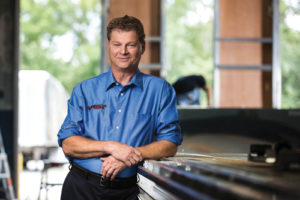 When the agreement expired in 1987, Verduyn began making his own tarps and incorporating the design ideas he’d worked on earlier. By the early ’90s, Verduyn started making retractable systems, which eventually led him to create the company’s signature product line in 1992—the Eagle Smart Tarp Retractable System. Verduyn designed the system to reduce tarping time, provide safety and versatility and be aerodynamic. And he started the design by talking to the people who use tarping systems—the drivers. “Before I first made a tarping system, I took the time to talk to drivers. They’re the ones who use the systems,” he says. “We had a pretty big steel company right beside Verduyn Tarps at that time, and it had quite a few tarp systems coming in and out of there. I would run over and ask the drivers what they liked and didn’t like about the system they had, and I used all that information to develop my own product.”
When the agreement expired in 1987, Verduyn began making his own tarps and incorporating the design ideas he’d worked on earlier. By the early ’90s, Verduyn started making retractable systems, which eventually led him to create the company’s signature product line in 1992—the Eagle Smart Tarp Retractable System. Verduyn designed the system to reduce tarping time, provide safety and versatility and be aerodynamic. And he started the design by talking to the people who use tarping systems—the drivers. “Before I first made a tarping system, I took the time to talk to drivers. They’re the ones who use the systems,” he says. “We had a pretty big steel company right beside Verduyn Tarps at that time, and it had quite a few tarp systems coming in and out of there. I would run over and ask the drivers what they liked and didn’t like about the system they had, and I used all that information to develop my own product.”
The Eagle Smart Tarp System was well-received in the industry, but Verduyn believes that no matter how good a product is, it can always be improved. And to improve the system he once again talked to the drivers. “We’ve produced quite a few changes to our system over the years by talking to the drivers,” he says. “The main one was putting a patented tie-down rail on our track in the late ’90s. The biggest complaint I kept hearing from them was that it was really tough to tie cargo down, so I tried to solve the problem by putting a tie-down rail right on the track.”
A few years later, after talking to a driver at a truck show in Toronto, Verduyn increased the height of the tarp system access door from 5 feet to 6½ feet tall. “This guy at the show had a neck brace on and started telling me how dangerous the 5-foot doors were,” Verduyn says. “All the systems out there that I knew of had 5-foot doors. He wasn’t using one of our systems, but the door height was the same. He stepped into the system, stood up too early and
broke two vertebrae. So we decided to change the door height—and came up
with the ‘6-foot-6 man door’ in the front of the trailer.”
Verduyn also changed the aerodynamics of his system as the result of talking to a driver in England. “Every trailer I saw there had what I call a big flat plastic thing on the front,” he says. “So I asked one of the drivers what it was. He said it was their aerodynamic width nose cone. Turns out you didn’t need that big bubble out front [that we had at the time]. All you need is at least a 6-inch radius on the corners to give you the aerodynamics.”
Of customization and kits
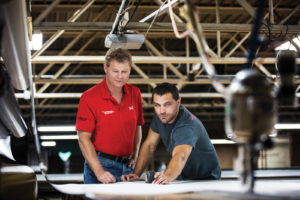
Now, Verduyn says things have progressed to a point where a lot of the improvements he conceived have become standard in the industry, and the focus of his continuous improvement has shifted to customization. “We deal with a lot of owner/operators and each one wants a system slightly different—they want to make it their own,” he says. “Some of these drivers practically live in these trucks and trailers, so they want them to look good so they can be proud of what they’re pulling.”
The other project Verduyn and his team are working on is developing an installation kit so that other companies can install the systems themselves. “These installation kits seem to be a recurring theme in the industry right now,” he says. “But there are a couple of issues we need to work out: we want to be confident that the system will be just as good as if we installed it ourselves, and because our track is in one piece, it’s a bit of a logistical problem to ship it efficiently.”
Verduyn’s approach to solving the problem is to bring it to his management team at the Hamilton location. “Right now we’re in the initial phases of figuring this out. We have three companies that are interested in becoming distributors for us. The main problem for us is that our track is in one piece as opposed to other companies, whose tracks are in sections. I’m not willing to sacrifice the strength of the system for logistics,” he says.
He gave the management team the overall goal—to make a kit that they can affordably ship out and can be installed consistently. “I prefer that everyone process the goal and come up with individual ideas about how to achieve it,” he says. “I think you get better results that way. Next we’ll bring all the brains together again and see what we can come up with.”
As Verduyn and his team work on a solution to this latest innovation, one thing is sure: quality and efficiency will remain at the foundation of the efforts.
“It takes a lifetime to build a reputation, but a very short time to screw it up,”
Verduyn says.
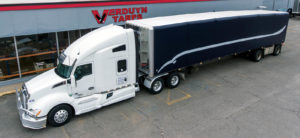 Smart tarping
Smart tarping
Lloyd Verduyn, owner and president of Verduyn Tarps, has made a career out of researching, developing and improving the Eagle Smart Tarp Retractable System to make it easier and more efficient for truck drivers to manage loads. Initially developed in 1992, the system provides a myriad of benefits to fleet owners. “The Eagle Smart Tarp is my biggest accomplishment,” Verduyn says. “It really makes me feel good when a customer tells me how much they love our system.”
The current system features a headboard with a quilted stainless steel finish, aerodynamic radius corners and a full-size man door. The headboard is customizable with exterior lights, and a special finish and/or interior storage options. The Eagle System tarps are made from high-quality PVC, available in a variety of colors, and can be constructed in one piece or in panels. Carts, lifters and 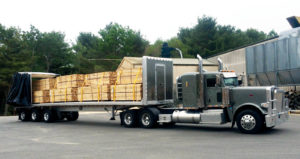 wheels are strong and durable, while the Eagle track is impact-resistant and equipped with its patented tie-down system. “We’ll never stop looking for ways to improve our system and make it easier for the drivers,” Verduyn says. “I think the average age of a driver is 56 now. One company wanted a system for an 82-year-old driver. That shows you how much easier it is to use our system rather than have to tarp a load yourself.”
wheels are strong and durable, while the Eagle track is impact-resistant and equipped with its patented tie-down system. “We’ll never stop looking for ways to improve our system and make it easier for the drivers,” Verduyn says. “I think the average age of a driver is 56 now. One company wanted a system for an 82-year-old driver. That shows you how much easier it is to use our system rather than have to tarp a load yourself.”
You’ve produced quite a few videos about how to use your tarping systems. How has that helped the business?
It’s fairly expensive to produce a video if you want to do it right, but it’s worth it. For the first one we did, however, I just videoed my foreman opening and closing the system. We showed him opening the system up, pushing the tarp all the way to the front, all the way to the back and then closing it all up. It took 3 minutes, 27 seconds. People loved it because it showed the actual time it takes to open and close the system—there was no editing. We put it on the internet and the comments we got were incredible. That’s when I saw the value of videos.
Now we hire a company to produce them for us, and we’ve got maybe 15 of them. They’re online, but also when we go to a truck show we have them looping over and over. Some are explanatory for our product and others are informational/educational. They’re all about three minutes long.
How have you used the principle of Kaizen in the company’s processes?
We always had the philosophy to some degree, but in the early 2000s we hired someone who helped us expand it to include how we managed inventory and ordering processes. Part of our need to improve our processes was because we were growing as a company and what worked before didn’t work any more. We used to have cards to track inventory. Everyone checked off when they used something. As we grew that system became impossible, so we moved to having one person in charge of inventory.
- Always be on the lookout for ways that products are different than what you’re familiar with.
- Talk to the people who use the products the most. Ask what they like and don’t like about what they’re currently using.
- Incorporate the help of key people within the company to brainstorm possible solutions.
- Consider several solutions before settling on one.
- Never sacrifice quality to solve a problem.
 TEXTILES.ORG
TEXTILES.ORG


